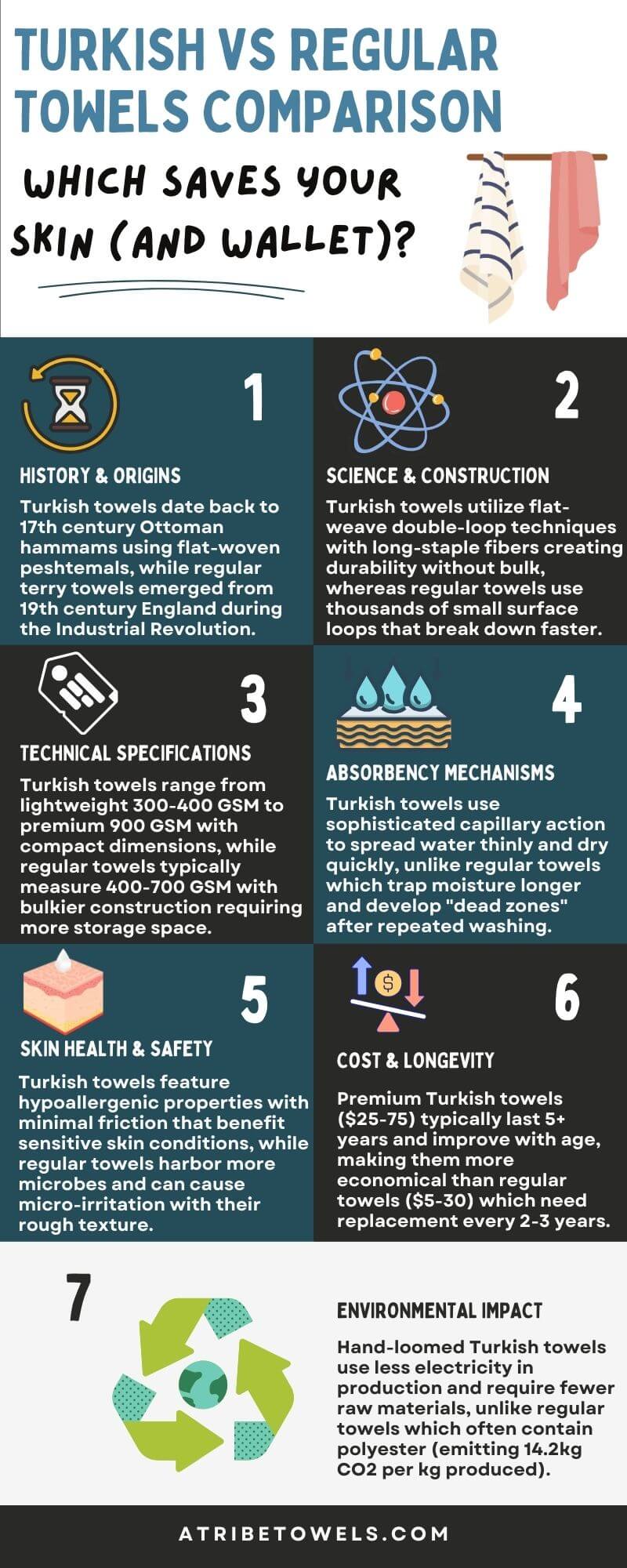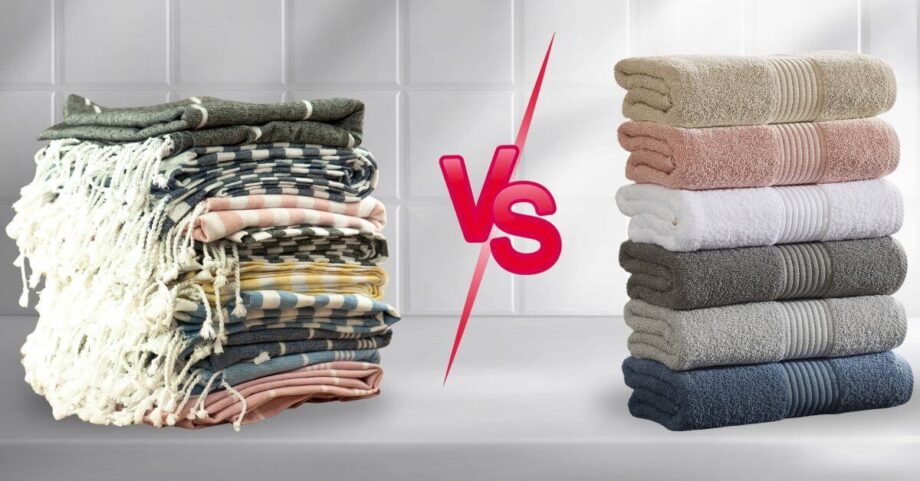The global bath towel market is already worth a whopping $11.3 billion, and customer preference is shifting toward premium-quality fabrics such as Turkish cotton, bamboo fibers, and Egyptian cotton. However, is this shift only because of the Instagram trends, where the growing majority of influencers use these colorful, visually appealing Turkish towels for Instagram-worthy snaps? Do Turkish towels have more to offer than photogenic shots? How about practical reasons like skin ease or space saving, higher absorption or long-lastingness, which also saves money? Let’s see:

History & Origins of Turkish vs Regular Towels:
Before we go into the benefits that directly affect your body, money and closet space, let’s explore where these different towel types actually come from. Their origins tell us a lot about why they perform so differently in your daily life.
| Feature | Turkish Towels | Regular Terry Towels |
| Origin | 17th century Ottoman Empire | 19th century England |
| Cotton Type | Long-staple Turkish cotton | Various cotton types |
| Design | Flat-woven | Looped terry cloth |
| Primary Use | Hammam bathing rituals | Household bath towels |
Turkish Towels:
Turkish towels have a rich heritage dating back centuries. Historical records show Ottoman hammams used flat-woven “peshtemal” towels as early as the 17th century. These authentic Turkish towels weren’t just functional items—they were part of an elaborate bathing ritual.
What makes Turkish towels special is their cotton. Long-staple Turkish cotton (Gossypium barbadense) is genetically distinct, producing stronger, silkier fibers. This isn’t just marketing talk—it’s actual plant science that explains why the best Turkish towels feel so different against your skin.
Regular Towels:
Your standard bathroom towel has a much more recent history. Terry cloth was invented in 19th-century England and patented by Samuel Holt in 1848.
The Industrial Revolution allowed for the mass production of these thicker towels, making them widely available. Their popularity exploded in the early 20th century as indoor plumbing became common in homes across America and Europe.
Science & Construction of Both Towels:
Turkish Towel Construction
Turkish towels use a flat-weave structure with long-staple fibers that creates serious durability without bulk. This isn’t just clever marketing—it’s textile science that explains why authentic Turkish towels last so much longer.
What makes the best Turkish towels special is their double-loop weaving technique. This method traps more water while keeping the towel lightweight. You get the absorbency without the heaviness of regular bath towels.
Many authentic Turkish towels still use traditional hand-looming. This creates tighter, more durable seams than machine production. Craftspeople take their time, resulting in towels that hold up through hundreds of washes.
Modern peshtemals feature decorative tassels or stripes, blending function with bohemian style. These aren’t just pretty details—they’re part of centuries-old weaving traditions that Turkish artisans have perfected.
Regular Towel Architecture
Your standard terry cloth towel relies on thousands of small loops to create surface area for water absorption. These loops stand up from the base fabric, grabbing water when you dry off.
Loop density directly correlates with GSM ratings and perceived plushness. GSM (grams per square meter) is how manufacturers measure towel thickness—higher numbers mean thicker, heavier towels.
Industrial manufacturing prioritizes immediate softness over long-term performance. Companies know most consumers judge towels by how they feel in the store, not their performance after 50 washes.
Regular towels often use shorter fibers because they’re easier to mass-produce but compromise longevity. These shorter fibers break down faster, creating that scratchy feeling over time.
Chemical treatments get applied to enhance initial softness but wash out over time. That’s why new regular towels feel amazing but quickly lose their appeal after a few laundry cycles.
| Feature | Turkish Towels | Regular Terry Towels |
| Fiber Length | Long-staple | Short to medium |
| Weaving Style | Flat-weave with double-loop technique | Terry cloth with surface loops |
| Production Method | Often hand-loomed | Machine manufactured |
| Thickness | Thin but highly absorbent | Thick and fluffy |
| Chemical Treatments | Minimal or none | Common for initial softness |
Technical Specifications Compared For Turkish & Regular Towels:
a. GSM (Grams Per Square Meter): The Density Benchmark
Turkish towels typically range from ultra-lightweight 300-400 GSM options perfect for travel to luxury-grade 600-900 GSM versions. The lighter ones dry faster than terry cloth, while the premium versions use double-loop weaving that traps more water without feeling heavy. The best Turkish towels balance weight and performance perfectly, feeling substantial without the bulk.
Regular towels usually fall between 400-700 GSM, with terry loops that prioritize initial plushness over long-term functionality. This higher density might feel luxurious in the store, but it retains more moisture, dramatically increasing mildew risk in your bathroom. Polyester blends offer lower GSM (300-500) but create other problems like microplastic shedding (higher shedding than other synthetic fibers like acrylic or polyamide) and reduced absorbency over time.
b. Material & Construction
Authentic Turkish towels are crafted from long-staple Turkish cotton, often called “white gold” for its exceptional properties. This specialized cotton creates towels with several standout qualities:
- Naturally hypoallergenic and surprisingly sand-resistant
- Flat-weave structure increases surface area by 40% compared to terry loops
- Long fibers create powerful capillary action for rapid water uptake
- Resistant to pilling and fraying, contributing to legendary durability
Regular towels commonly use mixed fibers and shorter cotton staples in length. While terry cloth’s 3D loop structure initially holds more water, it also traps bacteria if not appropriately dried between uses. The shorter fibers reduce overall absorption capacity, and loop collapse can decrease performance after just a few washes. This explains why your regular towels seem to stop working well after a few months.
c. Size & Space Efficiency
Turkish towels feature compact dimensions (typically 70″ x 39″) that fold down to just 1/4 the size of standard bath towels. They’re significantly lighter too, ranging from 200-400gms usually compared to the 500gms or more heft of regular bath towels. Their multi-use design eliminates the need for separate beach or picnic textiles, saving you both money and storage space.
Regular towels, especially oversized bath sheets (40″ x 80″), consume more storage space in your linen closet. Their bulk severely limits portability and versatility, and their single-use design means you need more storage space to cover all the functions a Turkish towel can handle. This space efficiency makes Turkish towels particularly attractive for small apartments or shared bathrooms.
d. Absorbency Mechanisms
Turkish towels work through sophisticated capillary action, spreading water thinly across their surface rather than trapping it in loops. They actually gain softness over your first few washes as fiber expansion improves flexibility. The long-staple cotton creates natural channels that effectively wick moisture away from your skin. Their flat-weave structure allows for even water distribution throughout the towel, while pre-washing activates the natural cotton fibers, enhancing absorbency with use. Unlike regular towels, they maintain strong absorbency capacity even after many wash cycles.
Regular towels excel at instant absorption but stay damp much longer afterward. Fabric softeners can coat the fibers, reducing absorbency per wash cycle. Loop collapse creates frustrating “dead zones” of reduced functionality, while chemical treatments often mask diminishing performance over time. Polyester content in blended towels reduces overall absorbency, and detergent residue can accumulate in dense loops, further affecting absorption capability.
Skin Health & Safety of Turkish vs Regular Towel:
Turkish Towels:
Authentic Turkish bath towels offer several skin benefits that many people overlook. The natural cotton, due to its hypoallergenic properties, helps prevent eczema flare-ups, especially if the towel is OEKO-TEX 100 certified. This makes them ideal for people with sensitive skin conditions.
Beach lovers appreciate Turkish towels’ impressive sand resistance. Their tight weave naturally repels sand particles much better than terry cloth. You won’t drag half the beach back into your car anymore.
The flat, smooth surface of Turkish towels minimizes friction against your skin. This reduction in physical irritation can make a huge difference for anyone with acne or eczema. The best Turkish towels feel gentle rather than abrasive.
- Natural fibers without chemical softeners significantly lower allergy risks
- Absence of raised loops is gentler on sensitive or compromised skin
- Smooth surface minimizes redeposition of oils back onto freshly cleansed skin
- High-quality cotton has natural properties that help resist bacterial growth
Minimal fiber shedding is particularly beneficial for respiratory sensitivities. You won’t breathe in tiny fibers while drying off.
Regular Towel Risks:
Your standard bath towel might be causing more problems than you realize. The loop structure can harbor significantly more microbes, potentially contributing to stubborn acne. Those fluffy loops create countless hiding spots for bacteria.
Terry loops effectively act as mild exfoliators. This works great for oily skin but can be surprisingly harsh on dryness or rosacea. The rough texture creates micro-irritation that compounds over time.
Regular towels often trap detergent residues in their thick piles. These hidden chemicals can trigger unexpected breakouts even if you’re careful with your skincare. The deeper loops simply hold more residue.
The moisture retention in standard towels allows bacteria to persist even after washing. This creates an ongoing cycle of reintroducing microbes to your skin daily. Authentic Turkish towels dry faster, breaking this cycle.
Cost & Longevity of Turkish vs Regular Terry Towels:
a. Initial Investment
Turkish Premium:
Authentic Turkish towels typically cost between $25–$75 per towel. This higher price point exists because artisanal hand-looming adds about 20% to the labor cost. Premium brands like Atribe’s organic cotton towels fall in the $35-$40 range, offering excellent quality without reaching the highest price tier.
Handcrafted designs command higher prices but deliver genuine craftsmanship you can actually feel. Many of the best Turkish towels come from companies practicing fair-trade production, ensuring ethical labor standards. The import costs affect retail pricing for authentic Turkish-made peshtemals, explaining part of the premium.
Regular Towel Economy:
Standard bath towels range from $5–$30 for mass-produced options. Manufacturers cut material costs when using polyester in their blends, but these significant savings rarely translate to consumer benefit.
Mass production enables economies of scale for lower price points. This explains why you can find cheap towel sets at big box stores. Loss-leader pricing is common in department store bath collections, tempting you with seemingly good deals.
Synthetic blends get marketed as “performance” towels to justify their polyester content, despite their inferior longevity.
b. Lifespan
Turkish Longevity:
The best Turkish towels actually improve with age. Natural fibers hold up remarkably well to UV exposure over time, making them ideal for outdoor use too.
- Can last 5 or more years
- $30-$70 total investment over 5 years
- Maintains structural integrity even in humid environments
- Handwoven edges typically outlast machine-stitched hems
Traditional weaving techniques create a durable fabric structure that resists breakdown.
Regular Towel Replacement Cycle:
Your standard bath towels typically last just 2–3 years before fraying begins. Synthetic blends degrade approximately twice as fast as pure cotton options. This rapid deterioration means you’ll spend more money replacing terry towels over the same 5-year period that one set of Turkish towels would last.
Loop deterioration becomes increasingly noticeable after multiple wash cycles. Common signs of wear include matting, color fading, and edge fraying. Harsh cleaning methods can accelerate fiber breakdown, especially in lower-quality towels. Even hotel-grade terry towels require regular replacement in commercial settings. Thread quality often diminishes with regular use over time, regardless of initial quality.
Environmental Impact
The production process for Turkish towels often involves hand-looming, which uses significantly less electricity than industrial manufacturing.
Many authentic Turkish towels are still made using these traditional techniques, supporting both cultural heritage and environmental sustainability.
The environmental footprint of regular towels starts with their materials. Producing just 1kg of polyester emits a whopping 14.2kg of CO2. Many regular towels contain significant amounts of these synthetic fibers, contributing to climate change.
Even cotton-only regular towels have environmental drawbacks. The terry cloth structure requires more raw material per towel. This increases the land, water, and pesticide use needed to grow enough cotton for each product.
Market Trends & Consumer Shifts
Younger demographics are clearly prioritizing eco-consciousness over traditional plushness. This explains the rising popularity of authentic Turkish towels among millennials and Gen Z consumers. A recent study published in MDPI’s Fibers journal revealed that 63% of respondents preferred cotton, while 47% actively avoided polyester products. Less than 8% avoided natural fibers like wool and cotton.
Social media has fueled demand for Instagram-worthy bathroom aesthetics. The distinctive patterns and tassels of Turkish towels photograph beautifully, making them popular content for home décor influencers. Their visual appeal extends beyond function into style territory.
There’s growing awareness of skin health considerations among everyday consumers. More people are making connections between their towels and persistent skin issues.
Atribe Boasts High-Quality Turkish Cotton Towels In Beautiful Designs:
Tilting toward getting that insta-worthy but also super practical and versatile Turkish Towel for your bath, picnics, beach trips, and gym sessions?
Why not check out the beautiful collection of fully cotton Turkish Towels available at Atribe? We have premium Turkish towels in different sizes, designs, and colors for every need.
Frequently Asked Questions:
What exactly are pestemals and how do they differ from terry cloth towels?
Pestemals are the traditional flat-woven fabric towels from Turkey that have been used in hammams for centuries. Unlike terry cloth towels which have thousands of tiny loops that stand up from the base, pestemals use a flat woven fabric technique that creates a smoother surface. This fundamental structural difference explains why pestemals dry faster, take up less space, and become softer with washing, while terry cloth towels remain thick and plush but take longer to dry and can develop a mildew smell if not dried properly.
What does GSM (grams per square meter) tell me about towel quality?
GSM (grams per square meter) measures the density of a towel’s fabric. Light towels (200-300 GSM) are thinner and dry quickly but may feel less substantial. Medium towels (300-450 GSM) balance weight and performance. Heavy towels (450-700 GSM) provide maximum plushness but dry more slowly. For Turkish towels, even a “heavy” 400-500 GSM pestemal will feel lighter than a standard terry cloth towel, while providing excellent absorbency through its unique weaving pattern rather than through bulk.
Are Aegean region cotton and 100% Turkish cotton the same thing?
Not exactly. 100% Turkish cotton refers to cotton grown anywhere in Turkey, while Aegean region cotton specifically comes from the coastal western area of Turkey known for producing extra long fibers that are particularly strong and smooth. This specific regional cotton is considered the highest quality due to ideal growing conditions that produce silkier, more durable cotton with less need for chemical treatments. The Aegean region’s traditional looming techniques often pair perfectly with this premium cotton to create authentic Turkish towels with superior durability.
How can a flat woven fabric be as absorbent as thick terry-backed bath sheets?
This is one of the most common misconceptions! Absorbency isn’t just about thickness—it’s about the cotton’s quality and structure. The smooth thread and extra long fibers in authentic Turkish towels create countless tiny spaces between threads that act like channels, pulling moisture away from your skin through capillary action. While terry cloth appears more absorbent because of its visible loops, those loops can actually collapse over time, while the flat woven fabric maintains its structural integrity and absorbency even after hundreds of washings.
Can Turkish towels really be used for more than just drying off after a shower?
Absolutely! The versatility of Turkish towels is one of their biggest advantages. Beyond functioning as a bath towel, a single Turkish towel can serve as a beach towel, blanket, wrap, scarf, tablecloth, throw, picnic mat, yoga mat cover, sarong, bath-suit cover-up, or even seat protector. Their lightweight, easy-to-fold nature makes them perfect travel companions. This multi-functionality aligns perfectly with sustainable lifestyle choices by reducing the need for multiple specialized textiles, which is why they’re becoming increasingly popular among eco-conscious consumers focused on ocean conservation.
Why do luxury hotels still use terry cloth towels if Turkish towels are superior?
Luxury hotels continue using thick terry towels from their luxe collection primarily because of guest expectations. While master weavers can create Turkish towels that outperform terry cloth in durability and actual function, many American hotel guests still associate plushness and weight with luxury. Additionally, terry towels paired with synthetic fibers are often less expensive for initial purchase (despite higher replacement costs), making them attractive for businesses managing operating expenses. However, some boutique hotels and eco-resorts are beginning to offer authentic Turkish towels as part of their commitment to sustainability over fast fashion trends.


